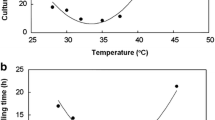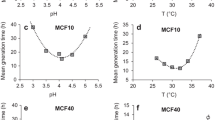Abstract
Thermo-acidophilic prokaryotes isolated from geothermal sites in Yellowstone National Park were identified as novel α-Proteobacteria, distantly related (~93% 16S rRNA gene identity) to the mesophilic acidophile Acidisphaera rubrifaciens. One of these isolates (Y008) was shown to be more thermophilic than all previously characterized acidophilic proteobacteria, with a temperature optimum for growth between 50 and 55°C and a temperature maximum of 65°C. Growth was observed in media maintained at pH between 1.75 and 3.0 and was fastest at pH between 2.5 and 3.0. The G + C content of Y008 was 71.8±0.9 mol%. The acidophile was able to grow heterotrophically on a range of organic substrates, including various monosaccharides, alcohols and amino acids and phenol, though growth on single organic compounds required the provision of one or more growth factors. The isolate oxidized sulfur to sulfuric acid in media containing yeast extract, but was not capable of autotrophic growth with sulfur as energy source. Growth occurred under aerobic conditions and also in the absence of oxygen via anaerobic respiration using ferric iron as terminal electron acceptor. Based on these genotypic and phenotypic traits, it is proposed that Y008 represents the type species of Acidicaldus organivorus, gen. nov., sp. nov.





Similar content being viewed by others
Abbreviations
- BS/TE:
-
Basal salts/trace elements
- FYM:
-
Ferrous iron/yeast extract liquid medium
- FYGM:
-
Ferrous iron/yeast extract/glucose liquid medium
- G + C:
-
Guanine plus cytosine
- PCR:
-
Polymerase chain reaction
- RISCs:
-
Reduced inorganic sulfur compounds
- TE:
-
Tris/EDTA buffer
- SSC:
-
Sodium chloride/sodium citrate buffer
References
Alexander B, Leach S, Ingledew WJ (1987) The relationship between chemiosmotic parameters and sensitivity to anions and organic acids in the acidophile Thiobacillus ferrooxidans. J Gen Microbiol 133:1171–1179
Bacelar-Nicolau P, Johnson DB (1999) Leaching of pyrite by acidophilic heterotrophic iron-oxidizing bacteria in pure and mixed cultures. Appl Environ Microbiol 65:585–590
Botero LM, D’Imperio S, Burr M, McDermott TR, Young M, Hassett DJ (2005) PolyA polymerase modification and reverse transcriptase PCR amplification of environmental RNA. Appl Environ Microbiol 71:1267–1275
Box JD (1981) Investigation of the Folin-Ciocalteu phenol reagent for the determination of polyphenolic substances in natural waters. Water Res 17:511–525
Chang S-S, Kang D-K (2004) Alicyclobacillus spp. in the fruit juice industry: history, characteristics, and current isolation/detection procedures. Crit Rev Microbiol 30:55–74
Cummings DE, Caccavo F, Fendorf S, Rosenzweig RF (1999) Arsenic mobilization by the dissimilatory Fe(III)-reducing bacterium Shewanella alga BrY. Environ Sci Technol 33:723–729
Don RH, Cox PT, Wainwright BJ, Baker K, Mattick JS (1991) Touchdown PCR to circumvent spurious priming during gene amplification. Nucleic Acids Res 19:4008–4008
Donachie SP, Christenson BW, Kunkel DD, Malahoff A, Alam M (2002) Microbial community in acidic hydrothermal waters of volcanically active White Island, New Zealand. Extremophiles 6:419–425
Dopson M, Baker-Austin C, Hind A, Bowman JP, Bond PL (2004) Characterization of Ferroplasma isolates and Ferroplasma acidarmanus sp nov., extreme acidophiles from acid mine drainage and industrial bioleaching environments. Appl Environ Microbiol 70:2079–2088
Felsenstein J (1985) Confidence-limits on phylogenies—an approach using the bootstrap. Evolution 39:783–791
Geller W, Klapper H, Salomons W (1998) Acidic mining lakes: acid mine drainage, limnology and reclamation. Springer, Berlin Heidelberg New York
Guay R, Silver M (1975) Thiobacillus acidophilus, sp. nov.; isolation and some physiological characteristics. Can J Microbiol 21:281–285
Hallberg KB, Johnson DB (2001) Biodiversity of acidophilic microorganisms. Adv Appl Microbiol 49:37–84
Hallberg KB, Lindström EB (1994) Characterization of Thiobacillus caldus, sp. nov., a moderately thermophilic acidophile. Microbiology 140:3451–3456
Hallberg KB, Kolmert ÅK, Johnson DB, Williams PA (1999) A novel metabolic phenotype among acidophilic bacteria: aromatic degradation and the potential use of these microorganisms for the treatment of wastewater containing organic and inorganic pollutants. In: Amils R, Ballester A (eds) Biohydrometallurgy and the environment toward the mining of the 21st century. Elsevier, Amsterdam, pp 719–728
Hallberg KB, Thomson HEC, Boeselt I, Johnson DB (2001) Aerobic and anaerobic sulfur metabolism by acidophilic bacteria. In: Ciminelli VST, Garcia O Jr (eds) Biohydrometallurgy: fundamentals, technology and sustainable development. Elsevier, Amsterdam, pp 423–431
Harrison AP Jr (1984) The acidophilic Thiobacilli and other acidophilic bacteria that share their habitat. Annu Rev Microbiol 38:265–292
Hiraishi A, Matsuzawa Y, Kanbe T, Wakao N (2000) Acidisphaera rubrifaciens gen. nov., sp. nov., an aerobic bacteriochlorophyll-containing bacterium isolated from acidic environments. Int J Syst Evol Microbiol 50:1539–1546
Holden PJ, Brown RW (1993) Amplification of ribulose-bisphosphate carboxylase oxygenase large subunit (RUBISCO LSU) gene fragments from Thiobacillus ferrooxidans and a moderate thermophile using polymerase chain reaction. FEMS Microbiol Rev 11:19–30
Johnson DB (1995) Selective solid media for isolating and enumerating acidophilic bacteria. J Microbiol Methods 23:205–218
Johnson DB, McGinness S (1991) Ferric iron reduction by acidophilic heterotrophic bacteria. Appl Environ Microbiol 57:207–211
Johnson DB, Ghauri MA, Said MF (1992) Isolation and characterization of an acidophilic, heterotrophic bacterium capable of oxidizing ferrous iron. Appl Environ Microbiol 58:1423–1428
Johnson DB, Bacelar-Nicolau P, Okibe N, Yahya A, Hallberg KB (2001) Role of pure and mixed cultures of Gram-positive eubacteria in mineral leaching. In: Ciminelli VST, Garcia O Jr (eds) Biohydrometallurgy: fundamentals, technology and sustainable development. Elsevier, Amsterdam, pp 461–470
Johnson DB, Dziurla M-A, Kolmert Å, Hallberg KB (2002) The microbiology of acid mine drainage genesis and biotreatment. S Afr J Sci 98:249–255
Johnson DB, Okibe N, Roberto FF (2003) Novel thermo-acidophilic bacteria isolated from geothermal sites in Yellowstone National Park: physiological and phylogenetic characteristics. Arch Microbiol 180:60–68
Jukes TH, Cantor CR (1969) Evolution of protein molecules. In: Munro HN (ed) Mammalian protein metabolism. Academic, New York, pp 21–132
Kishimoto N, Kosako Y, Tano T (1991) Acidobacterium capsulatum gen. nov., sp. nov.—an acidophilic chemoorganotrophic bacterium containing menaquinone from acidic mineral environment. Curr Microbiol 22:1–7
Kishimoto N, Fukaya F, Inagaki K, Sugio T, Tanaka H, Tano T (1995) Distribution of bacteriochlorophyll-a among aerobic and acidophilic bacteria and light-enhanced CO2-incorporation in Acidiphilium rubrum. FEMS Microbiol Ecol 16:291–296
Küsel K, Dorsch T, Acker G, Stackebrandt E (1999) Microbial reduction of Fe(III) in acidic sediments: isolation of Acidiphilium cryptum JF-5 capable of coupling the reduction of Fe(III) to the oxidation of glucose. Appl Environ Microbiol 65:3633–3640
Lovley DR, Phillips EJP (1987) Rapid assay for microbially reduced ferric iron in aquatic sediments. Appl Environ Microbiol 53:1536–1540
Macur RE, Langner HW, Kocar BD, Inskeep WP (2004) Linking geochemical processes with microbial community analysis: successional dynamics in an arsenic-rich, acid-sulphate-chloride geothermal spring. Geobiology 2:163–177
Marmur J, Doty P (1962) Determination of base composition of deoxyribonucleic acid from its thermal denaturation temperature. J Mol Biol 5:109–118
Nagashima KVP, Matsuura K, Wakao N, Hiraishi A, Shimada K (1997) Nucleotide sequences of genes coding for photosynthetic reaction centers and light-harvesting proteins of Acidiphilium rubrum and related aerobic acidophilic bacteria. Plant Cell Physiol 38:1249–1258
Okibe N, Gericke M, Hallberg KB, Johnson DB (2003) Enumeration and characterization of acidophilic microorganisms isolated from a pilot plant stirred tank bioleaching operation. Appl Environ Microbiol 69:1936–1943
Page RDM (1996) TREEVIEW: an application to display phylogenetic trees on personal computers. Comput Appl Biosci 12:357–358
Rawlings DE (2002) Heavy metal mining using microbes. Annu Rev Microbiol 56:65–91
Saitou N, Nei M (1987) The neighbor-joining method: a new method for reconstructing phylogenetic trees. Mol Biol Evol 4:406–425
Schleper C, Puehler G, Holz I, Gambacorta A, Janekovic D, Santarius U, Klenk HP, Zillig W (1995) Picrophilus gen. nov., fam. nov.—a novel aerobic, heterotrophic, thermoacidophilic genus and family comprising Archaea capable of growth around pH 0. J Bacteriol 177:7050–7059
Segerer A, Langworthy TA, Stetter KO (1988) Thermoplasma acidophilum and Thermoplasma volcanium sp. nov. from solfatara fields. Syst Appl Microbiol 10:161–171
Shively JM, van Keulen G, Meijer WG (1998) Something from almost nothing: carbon dioxide fixation in chemoautotrophs. Annu Rev Microbiol 52:191–230
Stackebrandt E, Goebel BM (1994) A place for DNA–DNA reassociation and 16S ribosomal-RNA sequence analysis in the present species definition in bacteriology. Int J Syst Bacteriol 44:846–849
Thompson JD, Gibson TJ, Plewniak F, Jeanmougin F, Higgins DG (1997) The CLUSTAL_X windows interface: flexible strategies for multiple sequence alignment aided by quality analysis tools. Nucleic Acids Res 25:4876–4882
Widdel F, Pfennig N (1981) Studies on dissimilatory sulfate-reducing bacteria that decompose fatty-acids. 1. Isolation of new sulfate-reducing bacteria enriched with acetate from saline environments—description of Desulfobacter postgatei gen. nov., sp. nov. Arch Microbiol 129:395–400
Wilson K (1987) Preparation of genomic DNA from bacteria. In: Ausubel FM, Brent R, Kingston RE, Moore DD, Seidman JA, Struhl K (eds) Current protocols in molecular biology. Green & Wiley Interscience, New York, pp 2.4.1–4.4.5
Acknowledgement
We thank Professor Akira Hiraishi of Toyohashi University of Technology, Japan, for the kind gift of As. rubrifaciens stain HS-AP3T.
Author information
Authors and Affiliations
Corresponding author
Rights and permissions
About this article
Cite this article
Johnson, D.B., Stallwood, B., Kimura, S. et al. Isolation and characterization of Acidicaldus organivorus, gen. nov., sp. nov.: a novel sulfur-oxidizing, ferric iron-reducing thermo-acidophilic heterotrophic Proteobacterium . Arch Microbiol 185, 212–221 (2006). https://doi.org/10.1007/s00203-006-0087-7
Received:
Revised:
Accepted:
Published:
Issue Date:
DOI: https://doi.org/10.1007/s00203-006-0087-7




